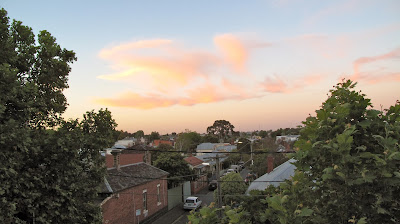 |
| The Artist's Wife, 1913 |
As a devotee of the Arts and Crafts
movement, Bernard Hall was always
interested in architecture. He was an active participant in the design of his
own house in Malvern, built in 1901, under the supervision of his good
friend, William Tappin, of the Melbourne architectural firm of Bates, Smart
and Tappin. A notebook Hall kept in the late 1890s anticipated many of
the features of this house, from its distinctive joinery to the delightful entry
window created by another good friend, the stained glass artist, William
Montgomery.
interested in architecture. He was an active participant in the design of his
own house in Malvern, built in 1901, under the supervision of his good
friend, William Tappin, of the Melbourne architectural firm of Bates, Smart
and Tappin. A notebook Hall kept in the late 1890s anticipated many of
the features of this house, from its distinctive joinery to the delightful entry
window created by another good friend, the stained glass artist, William
Montgomery.
It is not surprising then that
interiors – at least those that met his exacting
aesthetic standards – became a favourite subject for Hall’s work. Many
were painted at home, evidence of of his pride in his modest residence. The
Art Gallery of New South Wales has one of these domestic interiorss, titled,
as were several others, simply Chez Moi.
(http://www.artgallery.nsw.gov.au/collection/works/613/)
aesthetic standards – became a favourite subject for Hall’s work. Many
were painted at home, evidence of of his pride in his modest residence. The
Art Gallery of New South Wales has one of these domestic interiorss, titled,
as were several others, simply Chez Moi.
(http://www.artgallery.nsw.gov.au/collection/works/613/)

Chez Moi is a fascinating picture, as much
for its representation of a bygone lifestyle as it is for its artistic qualities.
Hall was a discriminating collector of finely crafted furniture, porcelain,
glass and metalware, and several choice items here command the viewer’s admiration. In
1936, some of his most cherished pieces were displayed at a retrospective
exhibition of his unsold work, reported by Argus
columnist, Joshua McClelland. McClelland’s description, which includes several
of the pieces in the Sydney Gallery’s painting, confirms the excellence of the
artist’s taste.
 |
| Chez Moi c. 1924 |
Chez Moi, however, is not the only interior painted by Bernard Hall in the Sydney Gallery’s collection. There is another - one so very important that I find it difficult to understand the curatorial mind-set that leaves it in storage, while others, like Clewin Harcourt’s much less remarkable One Summer Afternoon have been given a place on the walls.
Hall’s Interior (http://www.artgallery.nsw.gov.au/collection/works/835/),
was painted in 1926, in the house then occupied by the parents of a close friend, architect, Rodney
Alsop. This was ‘Mayfield’, the homestead designed by Georgiana McCrae in
1842 and built to overlook the Yarra at Studley Park. There is little question that Hall, who had
counted Georgiana’s children and grandchildren among his friends since his
earliest days in Melbourne, knew of its history.
‘Many years earlier (in 1907), the artist had challenged his colleagues’
obsession with the landscape, asking plaintively that ‘If light be the subject of every picture,
does it matter greatly where it falls, or what it illuminates?’ Few pictures
could illustrate the validity of his contention more evocatively than his Interior (Mayfield), in which the legendary
antipodean sunlight takes on a new significance.
Under its spell, polished floors gleam, their sheen reflecting the
subtly shaded creams of walls and ceiling. Light touches and calls attention to
a vase of flowers and the surfaces of pictures; it frames rugs and cushions and
glances off handcrafted furniture; it gilds and thereby celebrates the sculptural
massing of Georgiana’s architectural vision. A brass lamp by the foreground
desk adds its own wry commentary to the composition. Slanting light from the
window burnishes its shaft and casts a defined shadow on the adjacent wall. The
shadow draws the viewer’s eye to the floor, and a power cord, untidy, unlovely
and also ineffectual, as its plug lies disconnected on the floor.
The subtle irony of this vignette in a study where natural light has
been exploited to such expressive effect is perhaps too easily overlooked.
Throughout his life Hall asserted the importance of the Arts and Crafts ideal
as a buffer against the aesthetic decline he believed to be related to the
encroachment of modern technology. His Interior
(Mayfield) participated in this discourse.’
One of
the jewels of Australian architecture, ‘Mayfield’ was extended, altered and
renovated several times before being demolished in 1962, a victim perhaps of
the same outlook that consigns Hall’s painting to the obscurity of the
storage racks. If for no better reason than its celebration of the achievement
of one of the fledgling society’s most influential women, it deserves a more
prominent place
As no black and white photograph of Interior could do this painting justice I will not include the one I have. A colour reproduction can be found on the Gallery’s website or in my biography of the artist, although nothing of this sort can match the impact of a personal encounter. You only need to ask!
Do you know this picture?
Do you know this picture?
Mayfield is, of course, not the
only important residence to have been lost to the interests of developers. The picture
here was painted at another: ‘The Moorings’, the Toorak home of South Australian
grazier, George Logue Dickson and his wife Ida. After Dickson’s death, the
couple’s daughter, Viola, took it and other cherished possessions back to her
own home in South Africa, where it vanished from the record. If it has survived I would love to know where it is.









